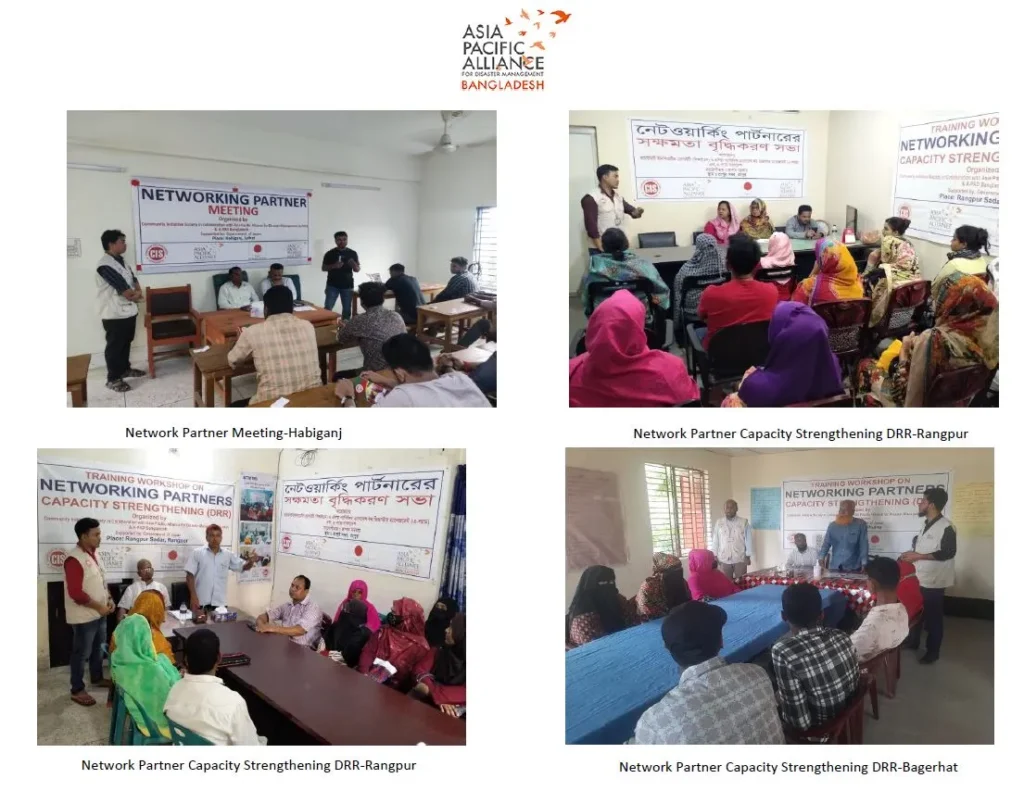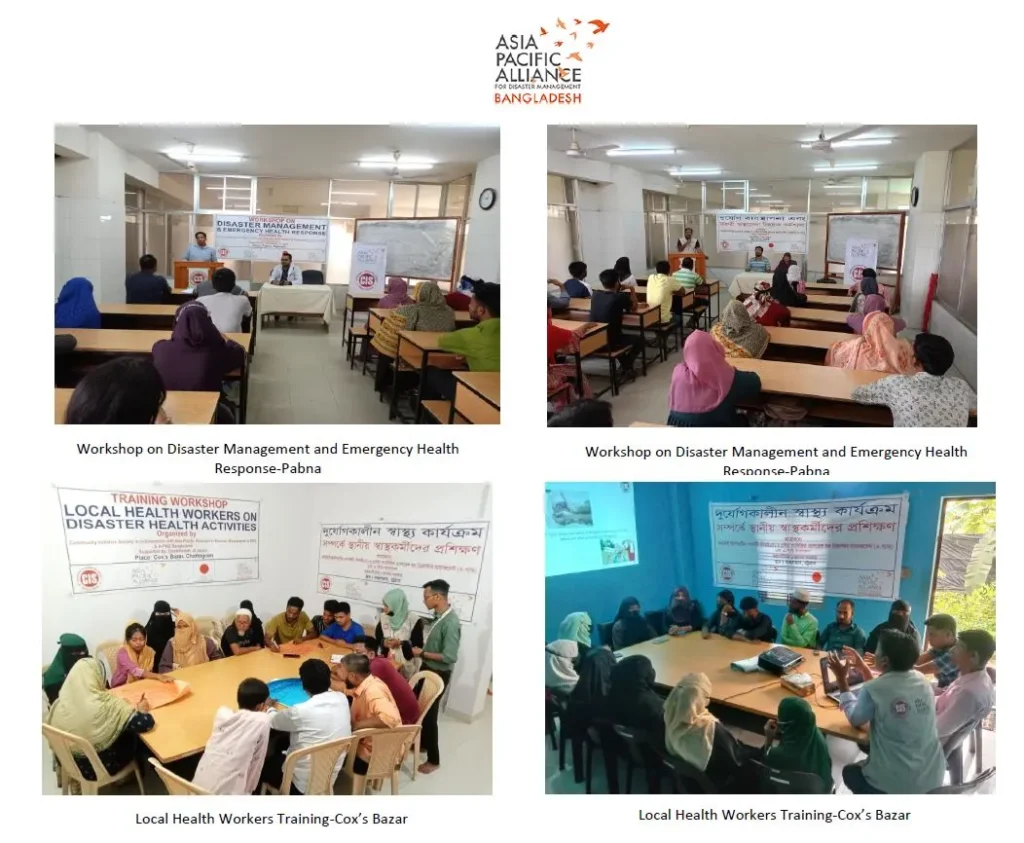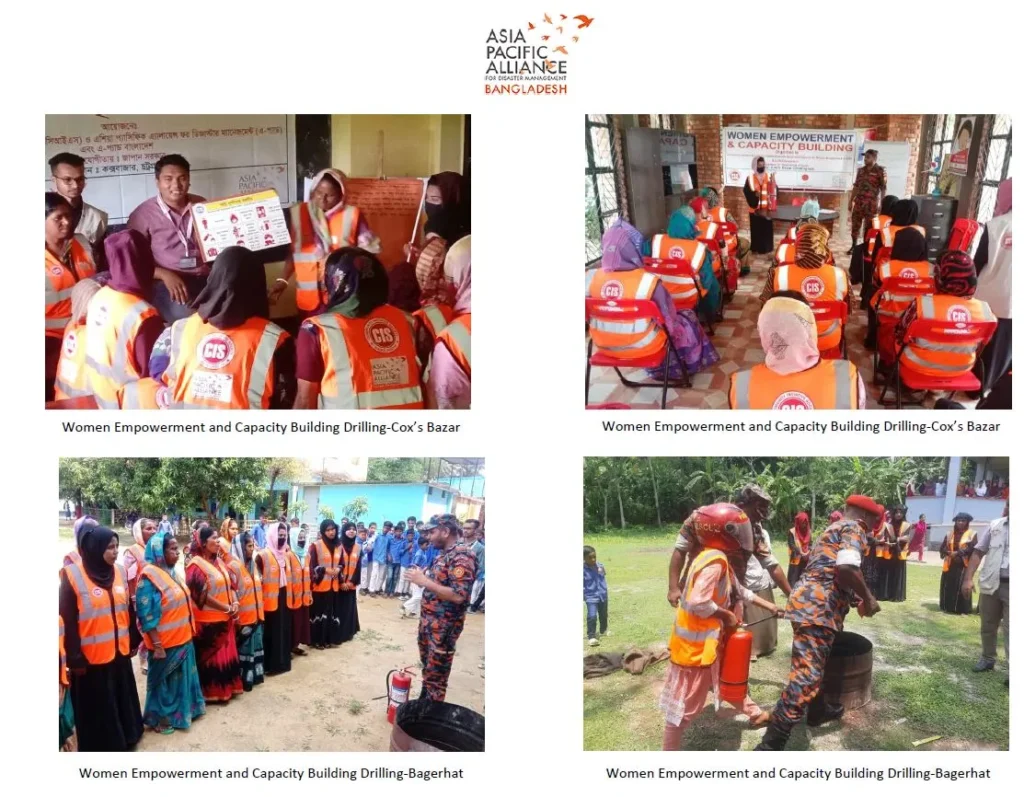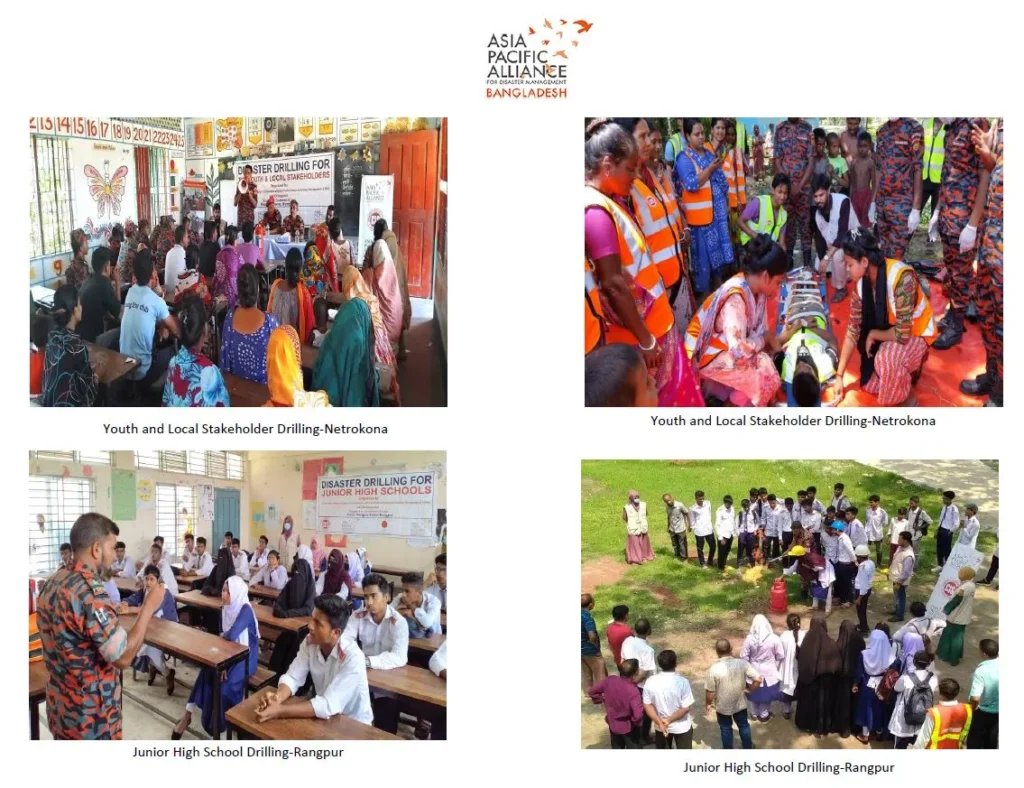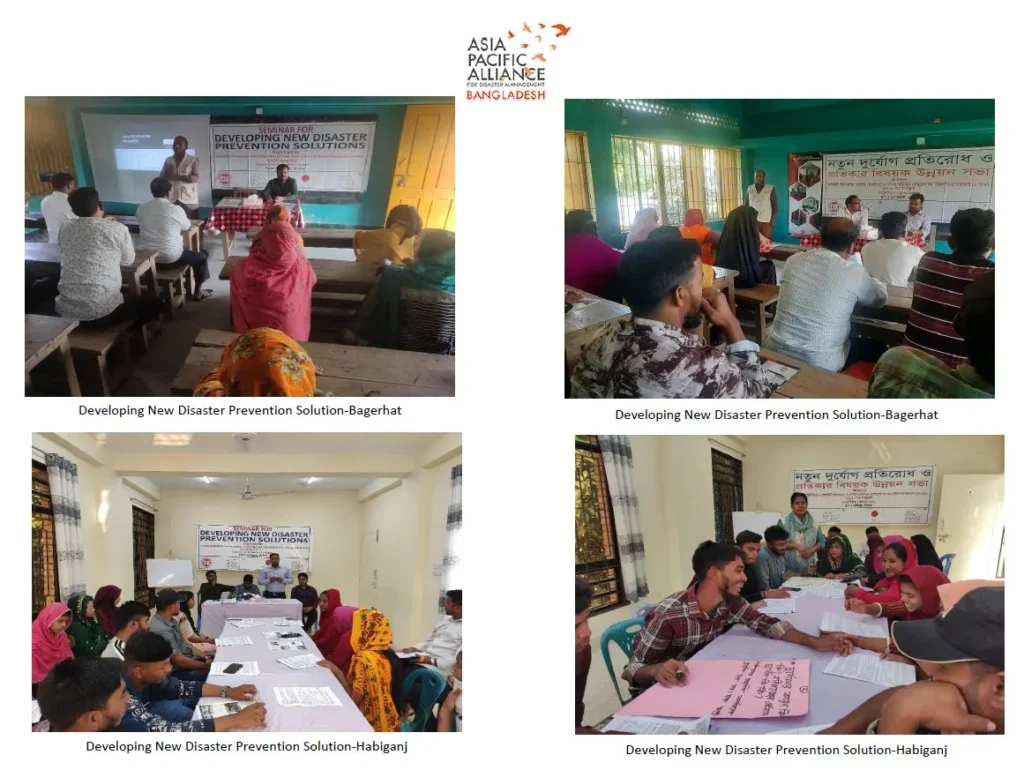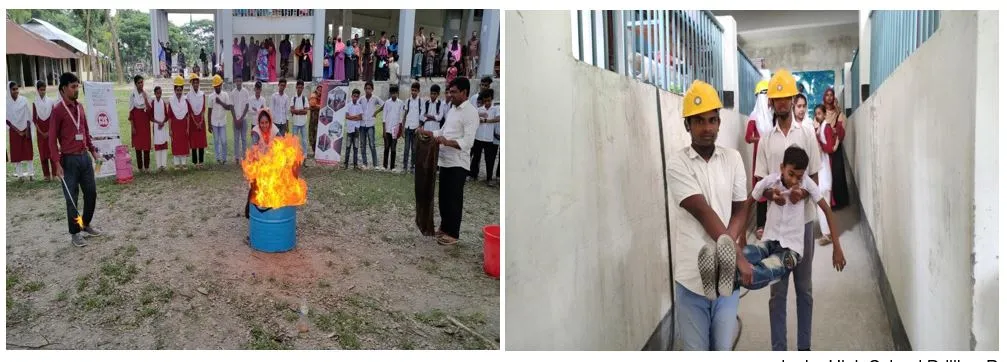Project Title: Strengthening Capacity for Sustainable Disaster Management Network by involving multi-sectoral platform Project Period: 17 January, 2024– 16 January, 2025 (12 month)
- Project Activities and Accomplishments
Bangladesh is ranking as one of the most disaster-prone countries. People in Bangladesh are often affected by water-related natural disasters, including floods, riverbank erosion and cyclones. In addition, recent rapid urbanization increases the risks for earthquake as well as man-made disasters. National Plan for Disaster Management (NPDM) 2021-2025 exemplified the strategic plan of the Government of Bangladesh in its Vision and the Mission of the Ministry of Disaster Management and Relief (MoDMR) between 2021 and 2025 towards building resilient nation. Bangladesh GOVT. has NPDM 2021-2025 has core goals for actions to save life, reduce economic losses in every disaster cycle stages which includes Disaster Risk Reduction (DRR), Humanitarian Response and Emergency Recovery Management. In Bangladesh most hazards impact: flood; cyclone and surge; tornado; earthquake; riverbank erosion; landslide; salinity intrusion; drought; tsunami; lightning; arsenic contamination; human-induced hazards and health hazards. The last hazard has potential for assuming significance because of the emerging risks in Bangladesh.
A-PAD Bangladesh started project from January 2023 and presently continue it 17 January 2024 to build up capacity on disaster management. It communicates with the different sectors like local community, community leaders, stakeholders, GOVT. officials continuing training on disaster management. To hold training program A-PAD Bangladesh staff organized small community meeting to sharing ideas on disaster and introduced them about A-PAD Bangladesh activity. A-PAD Bangladesh working 8 divisional areas.
There are 1 health workers in each divisions whose are doing home visit and aware the local community about basic disaster awareness. The health workers gave basic ideas about disaster management. A-PAD Bangladesh working at the rural areas. If there would be any directions or announcement from GOVT. or any disaster related news has been published the health workers delivered the message to the local community. Total 4,008 persons were benefited from A-PAD Bangladesh on May 2024.
A-PAD Bangladesh attended coordination meeting at the 8 divisions in Office of Deputy Commissioner. At that meeting different NGOs had joined and explained their activities. Besides this what will be the next activities of the GOVT. and NGOs were discussed at that meeting.
1. Strengthening of disaster risk reduction and disaster response system functions through the Emergency Disaster Management Coordination Center | ||
Activities | ( Outcome 1 ) The Emergency Disaster Management Coordination Center operated under this project will function as a disaster response base in each region, leading to the disaster risk reduction in the community and the strengthening of its disaster response system.: | Project Status: Achievements vs Outcome: If the activity is behind the schedule, please write the reason. |
1-1 Operation of Emergency Disaster Management Coordination Centers Target:Local communities 10 people×25 days×8 divisions×12 months =24,000 people | 【Indicators of Outcome】 1-1 The Emergency Disaster Management Coordination Center will be used for coordination meetings among partner organizations and relevant stakeholders during normal times, and will also serve as a center for health and public health guidance for the local residents. In the time of emergency, health services will be provided by emergency health workers. The Emergency Disaster Management Coordination Center will be used by 24,000 local residents (annual average) in the target area. (Indicator:number or visitors, record of services provided) 1-2 Through the Disaster Management Awareness Program, community residents will receive the latest disaster information and knowledge on how to respond to disasters, and people’s awareness of disaster prevention and response will be increased. (Indicator:Community disaster preparedness report) | Total 2,741 people visited to the Disaster Management Coordination Center to discuss about disaster preparedness and health related issues. Dhaka: 342 Persons Cox’s Bazar: 325 Persons Pabna: 338 Persons Bagerhat: 320 Persons Patuakhali: 318 Persons Habiganj: 387 Persons Rangpur: 376 Persons Netrokona: 335 Persons Total = 2,7941 Persons |
1-2 Disaster Management Awareness Program Target:Local communities, Community leaders, Local NGOs, Private company workers, government officials 15 people × 8 divisions × 4 times ×12 months =5,760 people | A-PAD Bangladesh conducted Disaster Management Awareness programs at the 8 divisional areas where 501 persons have participated. Total 4 times training organized at each divisional areas. Dhaka:15 Participantsx 4 Sessons= 60+3=63 Participants Cox’s Bazar: 15 Participantsx 4 Sessons= 60+1=61 Participants Pabna: 15 Participantsx 4 Sessons= 60 Participants Bagerhat: 15 Participantsx 4 Sessons= 60+2=62 Participants Patuakhali: 15 Participantsx 4 Sessons= 60+5=65 | |
|
| Participants Habiganj: 15 Participantsx 4 Sessons= 60+2=62 Participants Rangpur: 15 Participantsx 4 Sessons= 60+4=64 Participants Netrokona: 15 Participants x 4 Sessons= 60+4=64 Participants |
2. Expansion of disaster management network to improve community vulnerability | ||
| (Outcome 2)The network of NPF will be expanded and the capacity of each region for disaster prevention and response will be strengthened. |
|
2-1 Network Partner Meeting Target : Local communities, Community leaders, Local NGO, Private Company Workers, Government officials 50 people × 5 villages × 8 divisions = 2,000 people | 【Indicator of Outcome】 2-1 Strategies, mechanisms, and action plans for disaster reduction cooperation are developed in each region through discussions at network partner meetings, and a framework for disaster reduction cooperation is established. (Indicator:Strategic Plan) 2-2 MOUs signed with at least 5 new organizations, including private companies, in A-PAD Bangladesh NPF to expand the network (Indicator:number of new MOUs signed) 2-4 Resources possessed by A-PAD BGD partner organizations are provided in emergency disaster response, and play the role of that organization in times of emergency. | A-PAD Bangladesh organized 5 days Network partner Meeting at 5 villages in Habiganj. Total 261 participants has joined the meeting. 05 May 2024- Rajanagar: Total Participant- 50 Participants 06 May 2024-Digonta: Total Participant- 50+3=53 Participants 07 May 2024- Poil: Total Participant- 50+2= 52 Participants 08 May 2024- Teghoria: Total Participant- 50+4= 54 Participants 09 May 2024- Vadoy: Total Participant- 50+2=52 Participants The Networking Partners Meeting aimed to foster collaboration among diverse stakeholders, including governmental bodies, NGOs, community organizations, academic institutions, and private enterprises. By bringing together these stakeholders, the meeting provided a platform for dialogue and synergy, enabling the pooling of collective expertise and resources to build a resilient community. Through discussions and workshops, participants were able to identify common challenges and |
| (Indicator:List of resources such as supplies, human resources and donations provided by partner organizations for emergency disaster response) | explore innovative solutions to address the multifaceted issues related to disaster management. This collaborative approach promoted a holistic understanding of the challenges faced by Habiganj district and paved the way for coordinated efforts in disaster preparedness and response. |
| The Networking Partners Meeting focused on knowledge exchange and capacity building as essential components of effective disaster management. The five-day agenda included sessions on risk assessment methodologies, emergency response protocols, early warning systems, infrastructural resilience, and community-based interventions. These topics catered to the diverse interests and expertise of the participants, ensuring that critical issues were addressed comprehensively. By sharing best practices, lessons learned, and research findings, the meeting facilitated the transfer of knowledge among stakeholders, enabling them to enhance their capacity in disaster preparedness and response. This knowledge exchange further strengthened the network of collaboration and promoted a culture of continuous learning and improvement. | |
2-2 Disaster Preparedness Campaigns Target:Partner organizations and local communities 50 people × 2 times × 8 |
|
|
divisions = 800 people |
|
|
2-3 Network Partners Capacity Strengthening (DRR) Target : Partner organizations 20 people × 2 organizations × 2 times × 8 divisions = 640 people | A-PAD Bangladesh Organized Network Partner Capacity Strengthening DRR at 2 divisional areas in Rangpur and Bagerhat. 08-09 May 2024, Rangpur, Total Participants 40+3= 43 Participants 11-12 May 2024, Bagerhat, Total Participants 40+4= 44 Participants Effective disaster management requires the coordination and cooperation of various stakeholders from governmental bodies, NGOs, community organizations, academic institutions, and private enterprises. This essay explores the importance of collaboration and cooperation in disaster management efforts in Rangpur, focusing on the facilitation of collaboration, knowledge exchange, strategic alignment, partnership building, capacity building, community engagement, framework establishment, cultivation of a culture of cooperation, and commitment to action. In the context of disaster management, bringing together stakeholders from diverse sectors is essential to effectively address the challenges posed by natural disasters. Governmental bodies, NGOs, community organizations, academic institutions, and private enterprises all play unique roles and possess distinct expertise, resources, and networks that can contribute to enhancing disaster preparedness, response, and resilience. By creating platforms or forums for stakeholders to collaborate, share knowledge, and exchange ideas, valuable insights can be gained from each other’s experiences and innovations. |
The training workshop held in the Bagerhat district of Bangladesh on 11th and 12th May 2024 focused on capacity strengthening in disaster risk reduction. With a particular emphasis on collaboration between NGOs, government agencies, and beneficiaries, the workshop aimed to equip participants with the necessary skills and knowledge to respond effectively during and after disasters. Bagerhat district, located in the southern part of Bangladesh, is susceptible to cyclones, tidal floods, erratic rainfall, cold waves, arsenic contamination, and tornadoes due to its geographic location and weather conditions. This essay explores the key takeaways from the workshop and discusses the importance of networking and collaboration in disaster risk reduction efforts.
One of the primary objectives of the training workshop was to strengthen capacity in disaster risk reduction (DRR). By bringing together participants from various backgrounds and professions, the workshop enabled knowledge-sharing and networking, enhancing the overall understanding of DRR principles and practices. Disaster risk reduction aims to reduce the damage caused by natural hazards, such as cyclones, floods, droughts, and earthquakes, through prevention measures. It involves analyzing and addressing the causal factors of disasters, reducing exposure to hazards, lessening vulnerability of people and property, managing land and the environment wisely, and improving preparedness for adverse events. Additionally, the workshop emphasized the relationship between DRR and sustainable development, as sustainable development activities must also incorporate measures to reduce
|
| disaster risk. Through capacity strengthening initiatives, participants were equipped with the tools and strategies necessary to identify and manage disaster risks effectively. |
2-4 Seminar for Developing New Disaster Prevention Solutions Target : NGO, Disaster prevention related government organizations, Private sector personnels 30 people ( 2days ) × 8 divisions × 2 times = 480 people |
2 days seminar has been organized in Dhaka and Patuakhali. Total 67 participants from 2 divisional areas had joined the seminar. 05-06 May 2024, Dhaka, Total participants 30+2=32 Participants 15-16 May 2024, Patuakhali, Total Participants 30+5=35 Participants Disasters have devastating effects on both human lives and economies, often resulting in deaths, injuries, food shortages, and long-term consequences. To minimize the impact of disasters, it is crucial to anticipate their potential consequences and take proactive measures. In this context, the seminar conducted by CIS in Dhaka highlighted the vital role of non-governmental organizations (NGOs) in disaster prevention solutions in Bangladesh. This essay explores the key roles played by NGOs and the government in disaster prevention solutions in Bangladesh, focusing on community awareness and education, emergency response, disaster risk reduction, advocacy and lobbying, as well as partnership and coordination. NGOs in Bangladesh are actively engaged in raising awareness and educating communities about disaster preparedness and prevention. They organize training programs, workshops, and awareness-raising campaigns to |
|
|
| inform communities about the risks of disasters and how to prepare for them. For example, organizations like DCHT, CIS, BRAC and the Bangladesh Red Crescent Society conduct community-based disaster preparedness programs to educate people on emergency response strategies, evacuation plans, and medical first aid. These initiatives enhance community resilience and empower individuals to take appropriate actions during disasters. These organizations provide life-saving support and contribute to the recovery process, ensuring the well-being of affected individuals and communities. NGOs collaborate with communities in Bangladesh to identify and mitigate the risks of disasters. They provide technical support and assistance to help communities develop disaster risk reduction plans and implement effective risk reduction measures. For instance, organizations such as A-PAD Bangladesh work closely with vulnerable communities to enhance community preparedness. By building the capacity of communities to withstand disasters, NGOs contribute significantly to reducing the impact of future disasters. |
|
2-5 International Symposium on DRR Target : Government, Local government, private company, NOG, partner organization, representative of A-PAD member countries, etc. |
| |||
200 people |
|
|
3. Practical training to improve resilience of local communities | ||
| ( Outcome 3 ) Contribute to improving the disaster resilience of local communities through practical training. |
|
3-1 Disaster response capacity building of local community level in Health and hygiene field | 【Indicator of Outcome】 3-1 a) Establish networks of community leaders who can lead disaster response and emergency health response in all districts of Bangladesh. (Indicator:Number and the List of community leaders for disaster response/emergency health in each 8 districts.) |
|
3-1 a) Workshop on Disaster Management and Emergency Health Response | A-PAD Bangladesh conducted 2 days workshop at Netrokona and Pabna, total 56 participants joined the training workshop. | |
Target : Local residents, Community leaders, Local NGO workers 25 people ( 2 days ) × 8 divisions × 2 times = 400 people | b) Networks of human resources with the skills and know-how to respond to health emergencies will be established in all districts of Bangladesh to provide health services to the local residents in times of emergency. (Indicator:Data of NGO health personals who can respond in emergency. Number of residents who received the services in the cases of activities during emergency disaster in each 8 districts.) | 04-05 May 2024, Netrokona, Total 25+2=27 participants 14-15 May 2024, Pabna, Total 25+4=29 participants The correlation between DRR (disaster risk reduction) strategies and the health sector is significant. The recent training workshop held in Dhaka had a strong emphasis on enhancing capacity for disaster response and emergency health response before, during, and after a disaster. The workshop spanned two days and covered various sectors and topics. A total of 56 participants from the local community, health sector, local NGOs, and private organizations in Dhaka |
|
| actively participated in the training workshop. The |
| 3-2 a) Disaster preparedness training and drills will be documented in a manual, and | workshop prioritized aiding, supporting, and treating victims to save lives during disaster and emergency |
| women, youth groups, and local stakeholders who participate in the drills will be granted certificates of completion and work as disaster volunteer teams during actual disasters. (Indicator:Drilling Manual, Cases of activities in emergency disaster response) | response efforts. The initial day of the training focused on the primary disaster prevalent in Dhaka, which is mainly heat-related due to the city’s nature as a metropolitan area with extensive urbanization. Discussions during the workshop centered around methods to increase greenery at the household level to combat this issue. Bangladesh’s geographical location and geology make the country highly |
b) Disaster drills at junior high schools will be documented in a manual so that students who participate in the drills will have the skills to take appropriate action in the event of a disaster. (Indicator:Drilling Manual, Report of emergency disaster response) | vulnerable to a wide range of natural hazards, compounded by the effects of climate change and variability. Anthropogenic influences, such as urbanization, deforestation, and inadequate physical development planning, exacerbate this vulnerability, leading to elevated risks and impacts. | |
3-1 b) Training of Local Health Workers on Disaster Health Activities | A-PAD Bangladesh organized local health workers training at Pabna. Total 25 participants joined the training. 19-21 May 2024, Cox’s Bazar, Total 20+5=25 Participants | |
Target : Health workers who belong to local NGOs or civil organizations 20 people ( 3 days ) × 8 divisions = 160 people |
| The training program conducted by CIS for local health workers in Cox’s Bazar from 19-21 May 2024 was a comprehensive and detailed initiative aimed at enriching the knowledge and skills of local health workers in managing health-related issues during disasters. The program was thoughtfully designed to encompass a wide array of topics including disaster risk reduction, emergency response, and public health interventions during disasters, segmented into various modules, each addressing specific aspects of disaster health activities. Throughout the training, participants received instruction on methods for |
|
| conducting rapid health assessments, identifying and managing common health issues during disasters, and providing psychosocial support. The theoretical sessions were focused on establishing a solid knowledge base, while the practical sessions provided hands-on experience in applying learned skills and knowledge in simulated disaster scenarios. |
3-2 Strengthening disaster response capacities of local communities through disaster drilling training |
| |
3-2 a) Women Empowerment and Capacity Building | Two days drilling program organized in Bagerhat and Cox’s Bazar where 45 women has been joined the drilling program. | |
Target : Women’s groups in target villages 20 people ( 2 days ) × 8 divisions × 2 times = 320 people | 11-12 May 2024, Cox’s Bazar, Total 20+3=23 Participants 20-21 May 2024, Bagerhat, Total 20+2=22 Participants The program offers training and capacity building activities for women, focusing on topics such as disaster awareness, emergency response, and risk reduction. The training | |
| encompasses disaster preparation, safety protocols during | |
| disasters, and accessing assistance in their aftermath. By | |
| involving women in disaster planning, we aim to enhance | |
| their empowerment and contribute to building resilience in | |
| communities. Women provide unique perspectives in | |
| identifying disaster risks and fostering security for their | |
| families, thereby reducing stereotypes and discrimination. |
|
| In alignment with Community Initiative Society’s broader objectives, this program underscores our commitment to promoting women’s empowerment, capacity building, and creating a more equitable and sustainable society. Recently, CIS organized a two-day event specifically geared towards women’s empowerment and capacity building. The event was designed to equip women with the skills and knowledge necessary for assuming leadership roles and engaging in decision-making processes. Through a series of practical activities, participants were able to engage in experiential learning and skill development. |
3-2 b) Disaster Drilling for the Youth and Local Stakeholders Target:Youth in the local private and civic sector 45 people ( 2 days ) × 8 divisions × 2 times = 720 people | Youth and local stakeholder drilling program organized in Netrokona and Dhaka where 96 participants joined. 15-16 May 2024, Netrokona, Total 45+2=47 Participants 15-16 May 2024, Dhaka, Total 45+4=49 Participants
Netrakona district is one of the disaster-prone areas in Bangladesh. For geographic location and weather condition, cyclone, tidal flood, erratic rainfall, cold wave, arsenic contamination, and tornado are common in this area. The main focus on Disaster Drilling for the Youth was on build up on capacity on emergency response regarding heat stroke and other relevant recent disasters. CIS conducted a training program in Barhatta, Netrakona on 15th and 16th May- 2024, Two days. On first day of the meeting, Md. Rafiqul Islam, Team Leader, FSCD, |
|
| emphasized on the thunder lightening situation in Netrokona and all over the country as well. The temperature has been increasing due to deforestation randomly and erupting carbondioxide by the industries and many other issues etc. On the other hand the water level of the Surma river has decreased due to reduced rainfall in Sunamgonj. On 2nd day, Md. Shafiqul Islam, Community Leader said that the people of our locality especially the farmers working at the field during the sunlight with heavy temperature rise. CIS is playing an important role by creating awareness program and conducting such training, seminar and workshop on disaster reduction’s At the training, it was discussed what to do during summer days specially heat stroke and upcoming disasters caused by heavy rains during rainy season, rules for keeping dry food, teaching others what they learn. The training was of two days, for lecture parts and workshop at the program. Practical workshop with handout to the participants was access to practical knowledge of disaster preparedness. After completing the lecture session, the workshop of the program was demonstrated and the participants participated simultaneously in the practical session. The Disaster Drilling for the youth was very useful and importance for ensuring preparedness for upcoming disaster. All the participants of this training workshop were spontaneously participated in all sessions especially in the group discussion and practical session. CIS is committed to addressing these issues by implementing a range of programs and projects designed to empower youth in Netrokona and looking forward to contribute to the |
|
| transformation of Netrokona district on its journey to become a developed society with improved communities enhancing skilled resources. |
3-2 c) Disaster Drilling for Junior High Schools Target:School Children 40 people ( 2 days ) × 8 divisions × 2 times = 640 people | Disaster Drilling for Junior High School conducted in 2 Divisional areas Cox’s Bazar and Habiganj. Total 87 participants joined the drilling program. 13-14 May 2024, Patuakhali, Total 40 Participants 29-30 May 2024, Dhaka, Total 40+3=43 Participants 29-30 May 2024, Rangpur, Total 40+6=46 Participants | |
| Bangladesh is a more disaster-prone area. For geographic | |
| location and weather conditions, cyclones, tidal floods, | |
| erratic rainfall, cold waves, arsenic contamination, and | |
| tornadoes are common in this area. Community Initiative | |
| Society (CIS) in Collaboration with Asia Pacific Alliance (A- | |
| PAD) implementing a Strengthening Capacity for | |
| Sustainable Disaster Management Network by involving | |
| multi- sectoral Platform. In her speeches, she said, CIS role | |
| along with the CPP role is very important in natural disaster | |
| management. She said that this type of demonstration by | |
| volunteers can save lives and livelihoods if a disaster | |
| happens. It was also expressed hope that this kind of | |
| exercise would help the local people what to do before the | |
| disaster.Participants gave thanks to CIS team and expressed | |
| gratitude for organizing such kind of training. It is also | |
| added that local people as well as students will be able to |
|
| protect their lives and property during a disaster by the learning of the event. It is noted that CIS in collaboration with FSCD facilitated the mock drill programme. They have demonstrated what to do during cyclones, landslide floods, floods; floods caused by heavy rains, making stoves during floods, how to keep safe drinking water, what to do in case of fire, etc. They have demonstrated what to do during cyclones, landslides, floods, floods caused by heavy rains, rules for keeping dry food, teaching children to swim, making stoves during floods, how to keep safe drinking water, what to do in case of fire, etc. Students participated in the training session actively as they enjoyed the session. They shared that this training helps them to learn more about disasters and now they know how to save themselves in case of fire or any emergency incident. In the training session there was one demonstration session the student learned how to rescue and get oneself out in the time of earthquake. They also received a primary medical help lesson from CIS staff. This training helps them to have a primary knowledge in disaster emergencies and now they are willing to share their knowledge with their family members and other students. |
3-3 Update website contents as E-resources for Disaster Management | https://apad-bd.org/situation-report-cyclone-remal/ https://apad-bd.org/a-pad-bangladesh-activity-report- month-of-april-2024/ |
- Challenges
Please write Challenges and its impact upon the project implementation. (Ex. lockdown, Political situation, Curfew)
- Practice in collaboration with A-PAD Bangladesh Network Partners Please write good practice in collaboration with partner organizations
- Any contribution Funds Received and Grants Applied / Planned and Implemented Projects by CIS including Emergency Response
Please write Projects name and its fund resources
- Relationship with Bangladesh Government and Japanese Embassy
Please write about Meeting with Government officials

